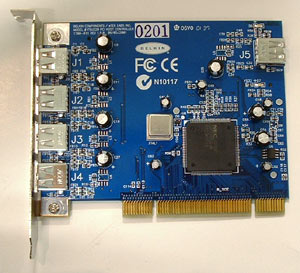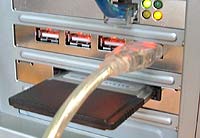
|
The members of the USB-IF (USB Implementers Forum) were not about to let USB die, so they came up with the USB 2.0 standard.
80% Rating: 
|
|
|
|
Home >
Reviews >
Peripherals >
Belkin F5U219 |
|
|
Belkin USB 2.0 Hi-Speed PCI Card Review
There is always room for more bandwidth; be
it CPU bandwidth, memory bandwidth or yes, even USB bandwidth. When USB1.1 was first released
it eclipsed parallel and serial ports with transfer speeds of 11Mb/s and now USB2.0 is on the sceen with transfer rates of 480Mb/s!  While IEEE 1394 Firewire has
already gained a lot momentum in the digital video world, it has not
posed much of a threat to USB in the trenches of day to day peripheral
management. On the high end of bandwidth intensive products, USB's dominance has been severely threatened since IEEE1394 offers approximately 40x more bandwidth at 400 Mb/s. While IEEE 1394 Firewire has
already gained a lot momentum in the digital video world, it has not
posed much of a threat to USB in the trenches of day to day peripheral
management. On the high end of bandwidth intensive products, USB's dominance has been severely threatened since IEEE1394 offers approximately 40x more bandwidth at 400 Mb/s.
The members of
the USB-IF (USB Implementers Forum) were not about to let USB die, so they came
up with the USB 2.0 standard, which up's the ante to a bandwidth of 480 Mb/s over the same four wire cable.
To meet the growing demand for USB2.0
compatibility Belkin have introduced a five port (four on the outside, one
internal) PCI card with a nice blue PCB. Personally speaking, I really like the red LED's at each port which remain lit when the card is powered on.
The Belkin USB 2.0 Hi-Speed PCI card uses the NEC D720100AGM
chipset which is the same as those found on most of the USB2.0 supporting
motherboards at this time. This way, users can update older systems by simply
dropping in the USB2.0 PCI card. The card retails for around $75 CDN, and
considering most Firewire cards come with just two to three ports for ~$100 this
is a pretty good deal. While USB 2.0 based peripherals have been
relatively slow to take off, devices that take advantage of the USB 2.0 are
starting to pop up everywhere from USB 2.0 harddrives to CD-RW's to networking
products. Does USB 2.0 really offer that much performance boost over USB 1.1? Well to find out we attached a
40GB 7200 RPM Samsung HDD to our USB 2.0 Media Bay
and ran a few
HDD tests... Let's see the benchmarks!
| test system specs: |
|
|
computer hardware: |
|
| processor: |
athlonxp 2000+ |
| clock
speed: |
1.66 ghz |
| Motherboards: |
Epox 8KHA+ |
| Chipsets: |
VIA KT266A |
| Videocard: |
MSI GeForce 3 Ti500 (MS-8850) |
| Sound Card: |
VIA AC'97 codec (onboard) |
| Network
Card: |
N/A |
| Memory: |
256 MB KingMAX DDR333 |
| Hard Drive: |
40GB IBM DeskStar 60GXP |
| CDROM: |
Panasonic 48x CD-ROM CR-594-B |
| Floppy: |
Panasonic 1.44MB Floppy Drive |
| Heatsink: |
ThermalTake Dragon Orb3 |
| PowerSupply: |
Antec 400W PSU |
| Software
Setup |
Windows 2000 Pro + SP2
VIA 4in1
4.37V
DetonatorXP 22.80 |
| Benchmarks |
SiSoft Sandra 2002 Pro
Winbench 99
1GB File
Transfer |
 Sisoft Sandra 2001
Sisoft Sandra 2001 |
Source: Sandra |
|
Sandra is designed to
test the theoretical power of a complete system and individual components. The
numbers taken though are again, purely theoretical and may not represent real
world performance.
| SiSoft Sandra 2001 Benchmark Results |
|
HDD Benchmark |
Score |
| 1. |
USB 2.0 |
11462 |
| 2. |
USB 1.1 |
974 |
| 3. |
Hard Drive |
26544 |
While no where
close to the actual internal HDD scores, USB 2.0 scores significantly higher then the
older USB 1.1 standard could with the same drive. A limiting factor here might be
the IDE ribbon in the USB 2.0 Media Bay. It's just a regular Ultra/33 IDE cable.
WinBench 99 is a
subsystem-level benchmark that measures the performance of a PC's graphics,
disk, and video subsystems in a Windows environment. WinBench 99's tests can run
on Windows 95, Windows 98, Windows NT, Windows 2000, and Windows Me
systems.
| WinBench 99 v1.2 Benchmark Results |
|
Drives |
Score |
Ranking |
| 1. |
Business Disk - USB 2.0 |
3020 |

|
| 1a. |
Business Disk - USB 1.1 |
N/A |
|
| 1b. |
Business Disk - HDD |
9730 |
 |
|
|
|
|
| 2. |
High-End Disk - USB 2.0 |
6890 |
 |
| 2a. |
High-End Disk - USB 1.1 |
N/A |
|
| 2b. |
High-End Disk - HDD |
27100 |
 |
We gave up
with using Winbench
99 on the Media Bay attached via a USB 1.1 ports because is was simply too slow,
and taking too long (I'm talking over five hours to run). With these
test, the USB 2.0 HDD scores about a third of what the regular HDD does in both the Business Disk
and High tests, but this may be misleading when we consider the results from
just transferring files...
 Simple HDD Data Transfer Simple HDD Data Transfer |
Source: PCStats |
|
We created two 512MB dummy files and used Windows
Explorer to drag and drop the two files from the internal HDD to the drive being
tested be it internal or external. The IDE controller and HDD both ran at
Ultra/100 with DMA enabled.
| 1 GB File Transfer |
|
Drives |
Time |
| 1. |
USB 2.0 |
90 sec |
| 1a. |
USB 1.1 |
1045 sec |
| 2b. |
HDD |
115 sec |
It's quite
surprising here that the hard drive connected via USB 2.0 outperforms the internal HDD in terms
of data transfer. Not just by a little, but by a whole 25 seconds! When you consider large data
transfers that time adds up a lot.
 Conclusions: Conclusions:
The
performance of the Belkin USB 2.0 Hi-Speed PCI card is very good
as you might expect from standard with supports data transfers of around 480Mb/s. When it is teamed up with an
external USB 2.0 hard drive USB2.0 displays some very impressive performance
characteristics which may ultimately give Firewire a run for its money.
With USB 2.0, external hard drives, CDRom's or even burners are now
a viable alternative to consider. For users looking to get on the USB2.0 bandwagon, and
don't wish to replace an aging but still useful motherboard, an
expansion card like the Belkin USB2.0 adaptor is a must have.
With a sticker price of about $75 CDN
price tag the card is not too expensive for a new technology, and
as USB2.0 becomes more mainstream it will undoubtedly drop in price. Overall, if you're interested
in adding USB 2.0 to your computer or need one for a specific application, you
won't be disappointed with the Belkin USB 2.0 Hi-Speed PCI card!
Contents of Article: Belkin F5U219
|
|
|
|
|

